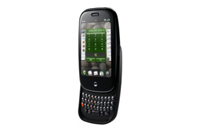Palm Pre review
Does the Palm Pre live up to the expectations of style conscious business users? Read our review to find out.

It’s slicker than using Symbian, arguably more pocketable than its top rivals the HTC Hero and iPhone and a valuable and valid alternative to the ever-expanding sea of Android phones we seem to be pelted with on a weekly basis these days. Updates would be welcome, but this is a good start.
The Palm Pre has large boots to fit its relatively diminutive frame into. Not only is it the most vehemently touted iPhone killer of the last 12 months, it's also the first phone to use the webOS operating system. It is seen by many as one of Palm's last chances to crack through the tech enthusiast shell and into the mainstream mobile market.
First impressions
It's with some trepidation then that we first slid back the Pre's QWERTY - with the king of PDA's fragile future cradled between our fingers. The first things to strike you are positives. The screen is luscious, with a bright image and vivid colours. As it has fewer inches and the same resolution compared to an iPhone, the pixel density on the Pre is greater, giving the impression of a sharper image.
Then there's the fact that unlike many smartphones currently flooding the market the Pre owns its design. There's no sense that the Pre is an identikit copy of other limelight-grabbing handsets on the market, which, shallow as it may sound, is a boon if you're looking to differentiate yourself from your BlackBerry- and iPhone-toting colleagues without compromising on features.
At the heart of the Pre's design is its slide-out QWERTY keyboard. However, it feels more like a non-slider mini-QWERTY, like the one seen on the budget BlackBerry 8520, than the full-length leviathans we normally see careening out from underneath smartphone screens. Such a form factor has its own share of benefits and negatives.
It makes sure that the Pre has the smooth lines to cut it as a simultaneous work and weekend device, but arguably doesn't let you get your typing speed up to full-length QWERTY levels. We spent quite a while typing emails and texts on the Pre to see how our fingers and thumbs fared, and although we eventually did get to faster speeds than we normally manage with an on-screen virtual keyboard, mistakes were more frequent too.
Get the ITPro daily newsletter
Sign up today and you will receive a free copy of our Future Focus 2025 report - the leading guidance on AI, cybersecurity and other IT challenges as per 700+ senior executives
-
 Cleo attack victim list grows as Hertz confirms customer data stolen – and security experts say it won't be the last
Cleo attack victim list grows as Hertz confirms customer data stolen – and security experts say it won't be the lastNews Hertz has confirmed it suffered a data breach as a result of the Cleo zero-day vulnerability in late 2024, with the car rental giant warning that customer data was stolen.
By Ross Kelly Published
-
 Women show more team spirit when it comes to cybersecurity, yet they're still missing out on opportunities
Women show more team spirit when it comes to cybersecurity, yet they're still missing out on opportunitiesNews While they're more likely to believe that responsibility should be shared, women are less likely to get the necessary training
By Emma Woollacott Published
-
 OpenAI wants developers using its new GPT-4.1 models – but how do they compare to Claude and Gemini on coding tasks?
OpenAI wants developers using its new GPT-4.1 models – but how do they compare to Claude and Gemini on coding tasks?News OpenAI says its GPT-4.1 model family offers sizable improvements for coding, but tests show competitors still outperform it in key areas.
By Ross Kelly Published